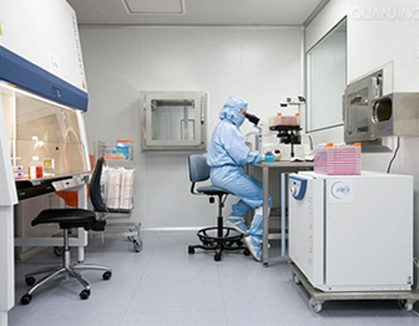
Greediness and desire put aside. A life-and-death story unfolds. For the blessed and healthy, it is another anecdote to hear.
For the unfortunate tumor patient, it is the story larger than life. It is a faithful believer’s most sincere wish that multiple rare ginsenosides saves more lives of tumor patients.
From Christian to Chief Scientist Specialized in Herbal Extraction
Named after the biblical figure who walked with the God for three hundred years before God took him, Canada Royal Enoch Phytomedicine Ltd. originated in faith and vision. Dr. Peihua Yu earned his Ph.D. from Germany and worked as a postdoctoral research fellow in Canada before becoming chief scientist at Enoch.
Years after Dr. Yu settled in Canada, his sister's suffering from stomach discomfort in 2011 brought him onto the quest for a safe and active agent. Could there be another option? Dr. Yu's endless search led him to natural herbs as the best field of hope.

Herbal Resources Are God's Gift to Cherish
Traditional Chinese Medicine is usually called "herbal medicine" in the West. However, there are critical differences between the western definition and the traditional Chinese notion, primarily because western medicine is based on compositions and ingredients, while the traditional Chinese practice is to boil dozens of herbal materials together into a pot without understanding the metabolic pathways and the chemical reactions behind it. Consequently, the Chinese practice, heavily dependent on passing on traditions from one generation to another, still largely fails to identify the effective ingredients and their safety index.
In fact, Chinese medicine has its merits. For many years, ingredients extracted from Chinese medicinal plants such as gingko and green tea are well researched by scientific institutions from other countries, and then made into products that sold back to China.
Authentic herb plants change their medical properties with the change of their growing environmental factors including climate, water, and soil, while the traditional formula of prescriptions passes down over generations and stays unchanged. This makes it hard to guarantee consistent clinical effectiveness in the long term. In the Chinese concept of "authenticity", or "Di-Dao", Di means land – the very soil and water from the place of origin; Dao means nature-the weather, rain, and everything else closely related to the growth of herbal plants. For example, Chinese yam grown in the provinces of Anhui and Jiangsu can look remarkably similar to yam grown out of Henan, but they have very different medical effects. The latter can be used in medicine, while the former is only useful as food.
"China's rich herbal resources are a gift from mother nature. We'd better cherish and make good use of it to benefit mankind." says Dr. Yu.


Devoted to herbal medicine research, we do four things
Heat-processing in the preparation of traditional Chinese medicine is similar to herbal processing in western medicine, and many such processed intermediates have to be metabolized in the body to become the final active ingredients.
Taking rare ginsenosides as an example, they are not readily obtainable from Araliaceae ginseng plants (Asian ginseng, American ginseng,panax notoginseng,etc.), and the raw plants must first be heat-processed and then be metabolized and/or biotransformed in vitro (outside the body) to form rare ginsenosides. At this stage, the final products are totally different from what is known as traditional Chinese medicine, or herbal medicine as known by westerners.
"We focus on rare ginsenosides based phytomedicine research from four aspects," says Dr. Yu. Firstly, plenty of biomedical research reports that ginsenosides in their natural-occurring forms (prototype ginsenosides), cannot be directly absorbed into the human body. They must first undergo proper gastrointestinal metabolism and be converted into rare ginsenosides before effective absorption could take place. This proposes considerable difficulties for individuals with poor digestive functions. To produce usable rare ginsenosides for direct absorption, our team developed its own proprietary technology that successfully conquered technical barriers in transforming prototype ginsenosides, thus yielding effective rare ginsenosides in large quantities.
Secondly, we devote to quality-based Araliaceae ginseng selection and in improving our drug preparation technology, so more metabolized and/or biotransformed active ingredients could be obtained. We choose to build our manufacturing workshop in Canada's Vancouver because North America provides a suitable environment for the growth of American ginseng, which after heat-processing becomes the more protoginsenoside-containing American red ginseng, with greater processing potentials.
Thirdly, rare ginsenosides are neither water-soluble nor lipid-soluble, and it is not easy for rare ginsenosides to reach the site of action inside the human body. Our R&D team devotes to finding a solution to transport rare ginsenosides inside the body.
Lastly, we focus on the specific healthy function and safety experiments, starting from in vitro cell culture experiments, to in vivo animal experiments, and eventually to human clinical trials, we invite internationally-recognized third party authorities for result verification.

"Do to others what you would have them do to you."
"So in everything, do to others what you would have them do to you, for this sums up the Law and the Prophets." --- Matthew 7:12, Bible.
Standing on the users' position, the Canada Royal Enoch Phytomedicine Ltd. R&D team ensures each Redsenol-1 Noble Ginsenosides capsule goes through 70 strict screenings (i.e. 5 heavy metal contaminants screenings, 5 microbial contaminants screenings, 60 pesticide residue screenings), and meets the standards of Health Canada and U.S. Pharmacopeial Convention (USP).
The R&D team in December 2015 used the CellTiter-Glo® Luminescent Cell Viability Assay (Promega; Cat. # G7573) to confirm the effects of Redsenol-1 Noble Ginsenosides Capsules on inhibiting cell proliferation in vitro. The experiments achieved ideal results.

The Birth of the Redsenol Multiple Rare Ginsenosides
Redsenol Rare Ginsenosides capsule features 16 rare ginsenosides, i.e. Rk2, Rg3 (S, R), Rh2(S, R), Rg5, Rk1, Rk3, Rh1(S, R), Rh3, Rh4, aPPT(S, R), aPPD(S, R). These active ingredients act together to exert synergistic effects and multiple rare ginsenosides are more effective than single ginsenoside.
Redsenol-DAG sublingual pill is made of 8 highly active rare ginsenosides that are meticulously selected, i.e. Rk1, Rk2, Rh3, Rg5, aPPT(S, R), aPPD(S, R). The high concentration of the 8 highly active compounds makes it more targeted.
Although Redsenol Rare Ginsenosides capsules and Redsenol-DAG sublingual pills are licensed as a natural health product by Health Canada, it has more medicinal properties in that it has a clear composition, clear efficacy, and reliable quality.
The word "redsenol" literally means "American red ginseng", and Redsenol's active ingredients are originated from the American red ginseng (heat-processed American ginseng) From 2005 to 2014, the R&D team strived to conquer technical barriers in bulk production of the rare ginsenosides Rg3, Rh2, Rh1, aPPD, aPPT, etc., and the more hard-to-obtain rare ginsenosides Rk1, Rk2, Rh3, Rg5, etc. on a large scale. The R&D team conducted plenty of research on the mechanisms of action of rare ginsenosides and confirmed their functions in enhancing human health.

